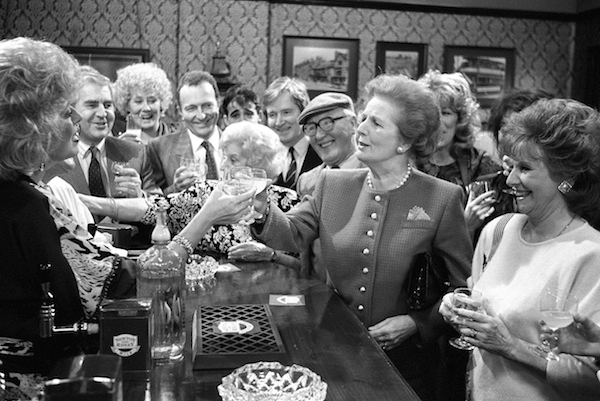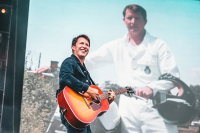Politicians can be divided into two categories; those whose public face is different from their private face and those for whom they are the same; put another way, those who feel it necessary in public appearances to put on an act, and those who manage to remain themselves. Among the latter are (or were) such disparate characters as Jack Kennedy, Willy Brandt, Jo Grimond, Edward Heath, Neil Kinnock; and among the former Adolf Hitler, Winston Churchill, Richard Nixon, Harold Wilson and Arthur Scargill (if you don’t like that list, you are welcome to make your own).
Prominent among the last-named is our Prime Minister, but she is almost unique in having not two faces but three. The first is the semi-private one, worn when she is not on public display; the second is the House of Commons one, seen and heard at Prime Minister’s Questions; and the third is the one adopted for television interviews. We are all familiar with the last two, but there can be few of us who have been given the opportunity to observe the first. It did, however, happen to me the year after Mrs Thatcher first came to power.
The occasion was the making of a BBC drama-documentary, of which I was the writer and presenter, on the life of Airey Neave, the MP who had masterminded her campaign for the party leadership and was subsequently assassinated by the IRA when a time-bomb blew up his car as it was leaving the House of Commons. Mrs Thatcher had agreed to give us an interview for the programme between 10.30 and 11.30 a.m. at No. 10 Downing Street. She arrived on the dot, chic and elegant as one had expected but also delightfully relaxed — knowing, of course, that it was not controversial political views that she was being asked to give but reminiscences of a much loved colleague and friend.
She knew exactly what was expected of her, and delivered it impeccably and on the first take; nor was there a moment when anything in her voice or manner distracted one from what she was saying. (Indeed the only distraction was a tiresome, buzzing fly which finally settled on the top of Mrs Thatcher’s exquisitely coiffured head. Rather than interrupt an interview that was going so swimmingly, Ben Rea, the director, decided to carry on in the hope that on transmission nobody would notice it. Except for the two of us, nobody did.) So flawless had been her contribution (I have deliberately eschewed the word ‘performance’) that by 10.55 the interview was over. I assumed that she would then shake hands all round and depart into the interior to attend to weightier things. Instead, looking at her watch, she said: ‘I see it’s just on eleven. I’m at your disposal until half past. Would you like me to show you round the house?’
For the next half-hour she took the eight of us on a tour of the public rooms, imparting with impressive assurance the history of this picture or that tapestry, anecdotes of what Pitt had done or Gladstone said. In the state dining-room with its rows of high-backed chairs, she said with a smile: ‘You know I had Giscard here last week. Where do you think I put him?’ We looked suitably baffled. ‘Here,’ she said, indicating a chair, and following her upward glance we saw on the wall opposite a full-length portrait of Lord Nelson next to a full-length portrait of the Duke of Wellington. Not once in that half-hour were we interrupted by a secretary with a message, not once did she give us anything but her undivided attention, not once was she anything but a charming and considerate hostess. We tottered into the street in a kind of glow.
Later came the number two face, that of Prime Minister’s Questions, which is now so different from the one we had experienced that you can hardly believe it is the same person. For a start the voice has dropped a couple of octaves into a sort of basso profundo so that you can imagine it belting out the ‘Song of the Volga Boatmen’ or, in harmony with Paul Robeson, ‘Ole Man River’. Abrasive and corrective, it is the voice of the games mistress, the colour sergeant, the first mate. You can hear it bellowing below decks: ‘Heave ho! Heave ho! Lash up and stow!’ or, ‘Call those boots polished, you horrible little man? I’ll call them polished when I can see your ugly mug in them!’
To be fair, one does have to ask how much this voice has developed through the extreme (and, in any other context, ungallant) provocations of Neil Kinnock and what John Wells calls the smelly socks brigade. Women, it may be said, and particularly this sort of woman, are not accustomed to being spoken to in this way, and if they are, this is how they will react. Would a male prime minister take the insults less personally, make a cooler, less aggressive response? I put the question but am uncertain of the answer.
And finally there is the number three or television interview face, as different from number two as number two is from number one. Safe in the knowledge that neither Brian Walden nor Robin Day will be trading Kinnock-style insults (and would be sacked if they did) she can afford to be gracious. Extreme femininity is the order of the day, and the blend of assumed intimacy with the interviewer (‘You know that as well as I do, Sir Robin’), mild flirtatiousness, emphasis on the first person singular and fingertip statistics, make for rum viewing. Words are stressed in a way they never are in ordinary conversation (‘Of course I’m deeply concerned — how could anyone not be?), giving an impression of someone not caring, when she probably does care quite a lot. In their artificiality and hollowness these performances rank with those of another quite different prime minister, Harold Wilson.
It is sometimes said of Mrs Thatcher that she is too partisan, too narrow in her outlook to heal the schisms in the country that she has largely helped to create, that while she is an able leader of the party which she represents, she can never speak for the country as a whole. Perhaps no prime minister can. Perhaps she sees that as a less desirable goal than pushing her policies through, regardless of dissent. In any case how can a prime minister hope to bridge the divisions within the country who has so many apparent divisions within herself? At the time of our visit to No. 10 back in 1980, this was not a question one ever thought to ask.





Comments